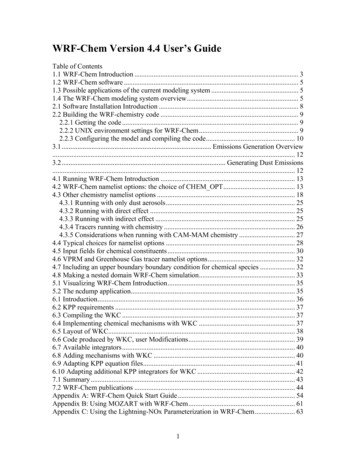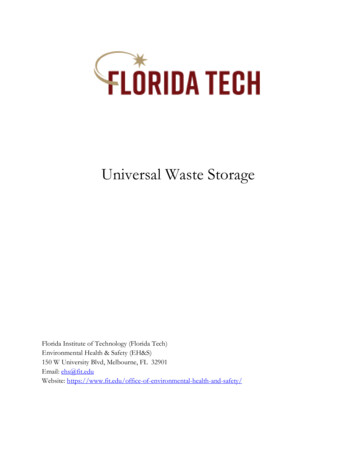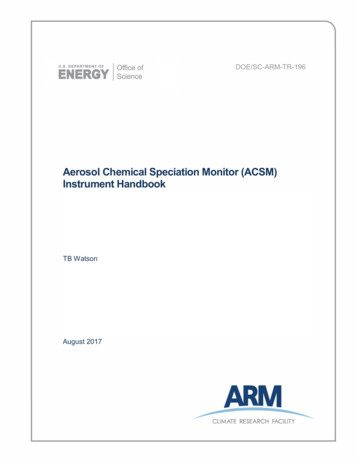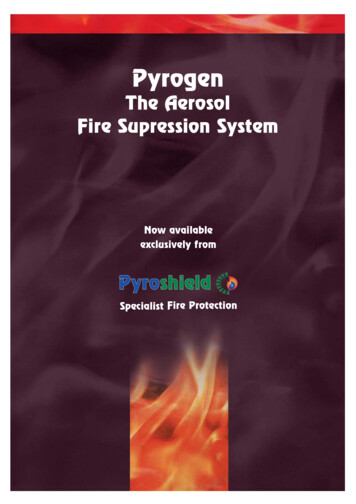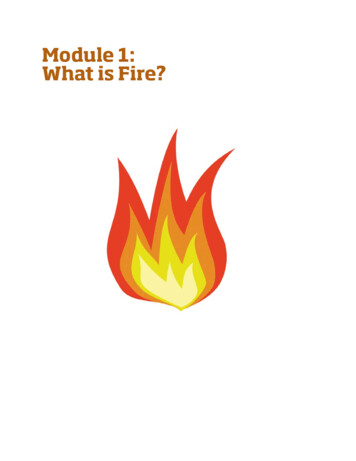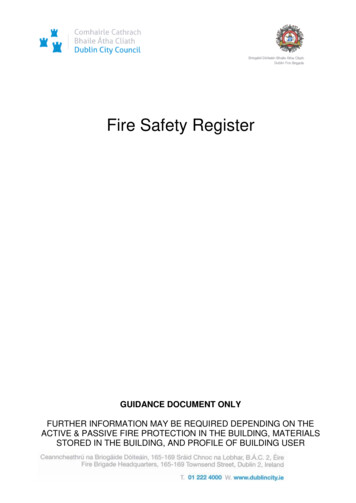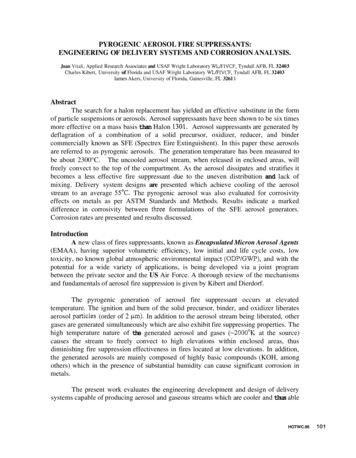
Transcription
PYROGENIC AEROSOL FIRE SUPPRESSANTS:ENGINEERING OF DELIVERY SYSTEMS AND CORROSION ANALYSIS.Juan Vitali, Applied Research Associates and USAF Wright Laboratory WL/FIVCF, Tyndall AFB, FL 32403Charles Kibert, University of Florida and USAF Wright Laboratory WLIFIVCF, Tyndall AFB, FL 32403lames Akers, University of Florida, Gainesville, FL 3261 IAbstractThe search for a halon replacement has yielded an effective substitute in the formof particle suspensions or aerosols. Aerosol suppressants have been shown to be six timesmore effective on a mass basis than Halon 1301. Aerosol suppressants are generated bydeflagration of a combination of a solid precursor, oxidizer, reducer, and bindercommercially known as SFE (Spectrex Eire Extinguishent). In this paper these aerosolsare referred to as pyrogenic aerosols. The generation temperature has been measured tobe about 2300 C. The uncooled aerosol stream, when released in enclosed areas, willfreely convect to the top of the compartment. As the aerosol dissipates and stratifies itbecomes a less effective fire suppressant due to the uneven distribution and lack ofmixing. Delivery system designs are presented which achieve cooling of the aerosolstream to an average 55'C. The pyrogenic aerosol was also evaluated for corrosivityeffects on metals as per ASTM Standards and Methods. Results indicate a markeddifference in corrosivity between three formulations of the SFE aerosol generators.Corrosion rates are presented and results discussed.IntroductionA new class of fires suppressants, known as Encapsulated Micron Aerosol Agents(EMAA), having superior volumetric efficiency, low initial and life cycle costs, lowtoxicity, no known global atmospheric environmental impact (ODP/GWP), and with thepotential for a wide variety of applications, is being developed via a joint programbetween the private sector and the US Air Force. A thorough review of the mechanismsand fundamentals of aerosol fire suppression is given by Kibert and Dierdorf.The pyrogenic generation of aerosol fire suppressant occurs at elevatedtemperature. The ignition and burn of the solid precursor, binder, and oxidizer liberatesaerosol particles (order of 2 pm). In addition to the aerosol stream being liberated, othergases are generated simultaneously which are also exhibit fire suppressing properties. Thehigh temperature nature of the generated aerosol and gases (-2000'K at the source)causes the stream to freely convect to high elevations within enclosed areas, thusdiminishing fire suppression effectiveness in fires located at low elevations. In addition,the generated aerosols are mainly composed of highly basic compounds (KOH, amongothers) which in the presence of substantial humidity can cause significant corrosion inmetals.The present work evaluates the engineering development and design of deliverysystems capable of producing aerosol and gaseous streams which are cooler and thus ableHOTWC.96101
to enter into thermodynamic equilibrium with ambient air at a much faster rate. In thecase of high temperature discharges the speed at which equilibrium is reached isdependent primarily on the mixing attainable in an enclosed volume. If the temperature islowered, mixing and thermodynamic equilibrium can be easily reached by normal freeconvection. Thus the primary objective in designing delivery systems is the lowering ofthe aerosol temperature. This can be accomplished by a number of heat exchangetechniques, including radiative heat transfer, convection, and conduction. At highgenerating temperatures it would seem reasonable to exchange heat by means of radiativetransfer. Although this might be the most effective method, it presents inherent hazardswhich may not be easily accommodated or resolved. A typical design would involve theuse of windows which would allow for most of the infrared energy to be dissipated tolower temperature bodies in the surroundings. This might in turn be a source of high heatflux capable of starting secondary fires.A more conventional approach is the use of convective mass transport as a meansof stirring and removing heat from the stream of aerosol. This would involve the use ofsecondary air streams impinging on the aerosol generating device at a rate sufficient toremove heat by diluting and mixing the original aerosol stream. While this approach mayseem reasonable it may be cumbersome to engineer.A more effective approach to removing energy from the aerosol stream involvesthe use of heat absorbing materials in the path of the aerosol stream. Heat absorbing orheat exchange materials are optimized such. that the rate at which heat is conducted iscomparable to the heat capacity of the material. This condition has allowed for the designof a delivery system composed of heat absorbing materials capable of cooling the aerosolstream to within ambient temperature range. This reduction in temperature allows for theaerosol to be dissipated and equilibrate to room temperature within reasonable settlingtimes (seconds versus tens to hundreds of seconds at about 2200 C).Analysis of the corrosion caused by the aerosol deposition on metals is ofimportance in determining the viability of using this aerosol technology in firesuppression scenarios. It has been found that the aerosol is composed mostly ofpotassium salts (KCI) and basics &OH). The deposition of these aerosols on metalsurfaces has been shown to cause significant corrosion. This paper discusses the results ofan ASTM standard study of corrosion applied to the deposition of SFE formulations A,B,and C.ENGINEERING DESIGN OVERVIEWTesting ProcedureThe tests were conducted in an enclosed area of dimensions 1.8 m x 1.8 m x 2.4 m (7.8m3) and K type thermocouples were placed at a distance of 5 cm away from the aerosolexhausting surface.102HOlWC.96
Air DischargeA measurement of the aerosol temperature as released unabated into free air isshown in Figure 1. The temperature stream peaks at 850 "C. The measurement was madeby placing a thermocouple at a distance of 5 cm away from the burning surface.900,Water CoolingAs stated earlier the design of an adequately cooled delivery system involved theuse of heat absorbing materials or fluids. Several trials using water as a coolant showedno significant improvement in the exhaust temperature. In this design, the aerosol streamimpinges on a U-tube design heat exchanger which is surrounded by water. The heatexchange generated steam and it was vented along with the aerosol producing a steamaerosol mixture. The resulting aerosol stream temperature history is shown in Figure 1.HOTWC.96103
600ItI/0The aerosol peak temperature reached 570 "C.Even though this represents a 33%reduction in peak temperature, it still represents a large enough temperature wherebysettling times are still quite high due to the buoyancy of the hot aerosol. This largetemperature is in part due to the comparatively low thermal conductivity of water and thefast heat generation rate of the aerosol precursors.Solid Bed CoolingThe use of heat absorbing materials to remove thermal energy from the aerosolstream follows from the need to remove heat at a rate similar to that at which it wasgenerated. Solids in general have better thermal conductivity than water, but not as gooda thermal heat storage capacity. Another important property of some solids is their highmelting point which helps to maintain structural integrity of the device. The principle ofcooling is based on allowing the aerosol stream to flow through a packed pebble bed ofthese heat absorbing materials. The packing of the bed is critical as optimizing the surfacearea of the pebbles is key to effective heat transfer from the stream to the heat absorbingmaterial. The surface area of the pebbles provides the basis for high convection and thusthe heat transfer rates to the pebbles is largely dependent on their packing and availablesurface area. Using relatively large pebbles, besides adding weight to the device, allowsfor a less constricted flow thus increasing the total path required for a give amount ofenergy removal, i.e. it would require more pebbles per unit length. On the other hand, apebble bed made up of smaller pebbles would present an even larger surface area104HOTWC.96
exposure to the aerosol per unit path length. Thus smaller surface area pebbles wouldremove more energy per unit path length from the flow.An additional concern is the adhesion of aerosol particles to the surface of thepebbles. Larger pebbles packed in a bed offer a smaller area to convective heat transfer tothe aerosol stream and thus less adhesive area for the aerosol. In the case of smallerpebbles the effective convective area is larger and thus the effective area for adhesion ofthe aerosol is also large. Thus an optimization process whereby the surface area andoverall total volume of the pebbles required to remove heat from the aerosol stream isrequired. Figure 3 shows the temperature history of an aerosol discharge using a bed of amixture of refractory materials to include magnesium and aluminum oxide.1000501001502002503 0Time (see)The peak aerosol temperature obtained in the refractory packed bed configuration wasabout 85OC. This allows for a settling time of a few seconds and therefore a moreefficient fire suppression in enclosed areas. The achievement of smaller ambient rangetemperatures allows for the optimization of the design.HOTWC.96105
AEROSOL GENERATOR DESIGNThe EMAA aerosol generator design has three major components; the housing(including combustion chamber), refractory/insulation material, and ignition system.Given the problems concerning efficient thermal transfer and containment, many differentcoolant systems were considered. Aerosol cooling must be coupled with insulating thehousing from the heat generated, therefore the possibility of a shapable refractorymaterial coupled with a packed-bed of spherical refractory media evolved as the mostfeasible approach. Housing for the generator must allow for high resistance to heat andthermal shock, no pressure buildup of aerosol, and maximum surface area for contactwith the aerosol without trapping excess aerosol particulate matter which could limiteffectiveness of fire suppression. Finally, a dependable ignition system with a fail-safedevice is needed.The charge is located at the bottom and a bed of pebbles of heat absorbingmaterials is placed above at a given distance away from the charge. The charge is ignitedby means of a magnesium firing squib activated by a 9 volt battery.MaterialsSeveral criteria were used to choose candidate materials. First, the materials musthave a melting point higher than that of the pyrogenic precursor emissions at 10 cm awayfrom the source. This limitation was imposed so as to avoid a meltdown of the coolingmaterial and a total obstruction of the aerosol stream, thus causing the potential foroverpressure and potential excursion resulting in an explosion. Second, the materialshould have as high a specific heat as possible. Third the material should be readily andcommercially available. Two materials were found which fulfilled these three mainrequirements. The materials used were magnesium oxide and aluminum oxide.Properties of these materials are shown in Table 1. These materials are commonly usedfor high temperature insulation and water filtering applications.1elting Point (C)luminum Oxide 11.09agnesium Oxide 11.17PO54p826nthalpy of Fusio1781111Table 1. Thermodynamic properties of heat absorbing materialsPacked Refractory Bed ThermodynamicsThe design and fabrication of the EMAA aerosol generator utilized refractories forthermal exchange and performance data of EMAA combustion. Ideally the goal for thegenerator is to cool the aerosol to approximately 80 C at discharge. From previous tests,the heat generated upon combustion for EMAA formulation A is 4007 KJKg, whichprovides 2003 KJ from a 0.5 Kg charge designed to provide coverage for a 10 m3 volume.106HOlWC.96
If water alone were used as a coolant, the amount necessary would be the amount of heat(2003 KJ) divided by the latent heat of water (2274 KJKg @ 1 atm @ 100 C) or 0.88 Kgof water. Unfortunately, because water vaporizes so quickly at these temperatures andhas such a low thermal conductivity, it alone is not a suitable candidate.As previously discussed, alumina (AI,O,) is an excellent refractory. The measureof alumina’s ability to cool the aerosol is measured by its specific heat at constantpressure, cp. This is defined as the quasi-static heat flux per mole required to produceunit increase in the temperature of a system maintained at constant pressure. Using the cpof alumina (1.09 K J K g K) and the overall system temperature change of 1300 K the heattransferred to the refractory is 1417 KJKg. If the total system heat is defined by Q, thenthe amount of alumina needed as refractory material is Q (2003 KJ) divided by thespecific heat cp (1.09 K J K g K) times the change in temperature (1300 K). Thus themass of pure alumina required is 1.4 Kg.In the case of magnesium oxide the specific heat is 1.17 K J K g K and using thesame data from above the amount of magnesium oxide required is 1.3 Kg.Generator Housing DesignPrimary considerations for the generator housing are heat resistance, andcontainment of the flame and potential pressure buildup produced from EMAAcombustion. Steel provides the benefits of heat resistance, availability, strength, andrecyclability or potential reuse. Steel tubing is also readily available in various-sizediameters and thicknesses, is easily machined, and provides adequate long-term corrosionresistance.The design for the 500 gram EMAA charge generator utilizes a 13 inch stainlesssteel tube with a 5 inch outside diameter, and 0.12 inches thickness. The sealed end ofthe housing uses 4 bolts, evenly spaced, and welded to the interior wall of the tube so asto secure a 0.125 inch thick plate. This plate has a machined lip to provide a uniform sealwhen bolted, and also has a central port with the necessary diameter to connect the ignitorsquib at the EMAA charge to the ignition system. Beneath the plate is a 1.5 inch gap,which provides a buffer-zone between the top of the EMAA charge housing and theinterior of the plate. This housing consists of a 2.25 inch section of 3.0 inch outsidediameter stainless steel tubing centered within the generator. The housing rests on a 0.1inch stainless steel mesh secured by two 0.125 inch stainless rods connected to thegenerator body. The space between the charge housing, the top plate, and the generatorbody is filled with high-temperature resistant alumina fiber blanket, which is easilycontoured to fill these voids. This blanketing acts to reduce flame contact with thegenerator wall, and provides insulation and added thermal transfer.Upon combustion, the aerosol flows through 9.0 inches of the packed-bedconfiguration of 0.25 inch alumina spheres, cooling it before it exits via an identicalstainless steel mesh arrangement at the open end of the generator. Even with the largeamount of void space in the packed-bed and relatively unrestricted flow from the chargeHOTWC.96107
housing to the outside space, possibility of pressure buildup from combustion should betaken into consideration.Ignition SystemIgnition of the EMAA charge within the combustion chamber is via a temperaturespecific thermocouple. This thermocouple uses two dissimilar metals that produce acurrent when heated. This current completes a circuit between a 9V battery and amagnesium ignitor squib which is inserted into the primer of the EMAA charge. Inaddition, a fail-safe ignitor should be considered, possibly a paraffin-coated woven cordrunning into the EMAA primer. In the case of a failed electrical ignition, this wouldprovide fuse-type ignition of the EMAA charge.CORROSION ANALYSISOne of the concerns regarding the use of the pyrotechnically generated aerosol ishow corrosive they may be due to prolonged contact with various metals and metalalloys. Depending upon the composition of the starting materials, the pyrotechnicallyproduced aerosol can consist of potassium chloride (KCl), potassium hydroxide (KOH) ,and or magnesium hydroxide(Mg0H). Considering the many ways the aerosol may beutilized, it is possible for the potentially corrosive alkali salts produced upon combustionto come in contact with a variety of different metal surfaces. For this reason, thispreliminary study provides an assessment of corrosion damage on samples of tencommonly used metals and metal alloys. This report provides data and results from astudy lasting approximately 30 days. It should not be extrapolated to predict results forlonger times of exposure, because corrosion does not always occur uniformly withrespect to time. Some metals form passive films that indicate high initial corrosion rates,but after film formation, these rates fall dramatically. Prolonged testing of these types ofmetals and metal alloys allows for these films to be broken down, and more accuratecorrosion assessment to occur. A suggested guideline for test duration from theAmerican Society of Testing and Materials (ASTM) is: duration (hours) 2000/(anticipated corrosion rate in mils per year). By using a test period ofapproximately 30 days for EMAA, a reasonably good assessment of corrosion damagemay be predicted. It should also be noted that indoor environments, atmosphericconditions, airborne pollution, temperature, wind direction, and design features, allpotentially affect corrosion types and rates. For this reason results should be consideredindicative of potential corrosion rates and types.POTENTIALLY CORROSIVE AGENTS IN EMAA FORMULATIONSMagnesium HydroxideMagnesium hydroxide MgOH, is a white powder that is very slightly soluble in water. Itdecomposes at 350 C (662 F). Magnesium hydroxide is formed by the reaction ofsodium hydroxide and a soluble magnesium salt solution.108HOTWC.96
Potassium ChloridePotassium chloride, KCI, also known as potassium muriate and sylvite, is a colorlesscrystalline solid with a salty taste that melts at 776 C (1420 F). It is soluble in water, hutinsoluble in alcohol. Potassium chloride is used in fertilizers, pharmaceuticals, and as asalt substitute.Potassium HydroxidePotassium hydroxide, KOH also known as caustic potash, lye, and potassium hydrate, is awhite crystalline solid that has a melting point of 360 C (680 F). It is soluble in waterand alcohol. It is a powerful cleansing bath for scouring metals and when used in steelquenching baths gives a higher quenching rate than water alone without attacking thesteel as a salt solution would. Potassium hydroxide is slightly more aggressive in thecorrosion of metals and nonmetals than sodium hydroxide.Corrosion AnalysisResults are reported in the following three categories: corrosion rate (mils peryear), mass loss percentage (grams per square meter), and pitting density (frequencyper square millimeter). Both corrosion rate and mass loss percentage refer to relativelyuniform, generalized attack, while pitting density refers to more localized, non-uniformattack.CORROSION RAES (mpy)ALUMINUMSTAINLESSMAGNESIUMFigure 4. Corrosion Rate of SFE Formulations (milslyear)
Corrosion Rates, SFE Formulation ACorrosion rates for coupons exposed to SFE-A formulation (Figure 4) vary fromtrace corrosion, 1.0 mpy for monel 400, nickel, and stainless, to much heaviercorrosion of carbon steels (1020 and 607), aluminum, and magnesium, (12.0 - 32.0 mpy).Zinc, brass, and copper sustained comparable corrosion rates in the 4.0 - 5.5 mpy range.Mass loss percentages (Figure 5) are comparable to the corrosion rates. Monel 400,nickel, and stainless had trace mass loss percentage, 0.01 %. Zinc, brass, and copperexperienced similar losses, 2 0.02 %. Steel 607 and aluminum showed mass losspercentages 3 0.045%, steel 1020 0.08% and magnesium approaching 0.14%. Pittingdensity was uniform among all sample coupons (Figure 6), 0.3 frequency per squaremillimeter, except aluminum which experienced severe localized attack, z 2.7 fiequencyper square millimeter.M4SS LOSS % 0 SFEFigure 5. Corrosion Rate for SFE Formulations (Mass Loss)Corrosion Rates, SFE Formulation BCorrosion rates for coupons exposed to SFE-B formulation were far more uniformthan those for SFE-A, and fall within acceptable levels for all samples. Monel 400,nickel, steel 607 and 1020, and stainless all had trace corrosion, 4 . 0 mpy. Zinc, brass,copper, aluminum, and magnesium had higher, but acceptable rates, 3.0 - 6.0 mpy.Mass loss percentages were also more uniform than SFE-A, with no sample ,024 YO.
Figure 6. Corrosion Rate for SFE Formulations (Pitting Density),PITTING DENSITY (GlM2) SFEALUMINUMSTAINLESSMAGNESIUMEight of the ten samples experienced nominal pitting density. Brass and aluminumexperienced some increased frequency of localized attack, although the severity anddepth of the pitting was not as great as caused by SFE-A.Corrosion Rates, SFE Formulation CCorrosion rates for SFE-C were indicative of rates obtained from exposure toSFE-A. Monel 400, nickel, and stainless experienced nominal corrosion rates. Zinc,copper, and brass showed higher, but acceptable rates, and highest rates were againpresent in steel (607 and 1020), aluminum, and magnesium. Mass loss percentages werealso indicative of rates obtained from exposure to SFE-A, as was pitting density.RECOMMENDATIONSThe various SFE formulations are effective in fire suppression only when totalflooding conditions are achieved. Initial estimates provide predict total-flooding to occurat 50 grams SFE in aerosol suspension per cubic meter of coverage area. Results fromHOTWC.96111
testing indicate that approximately 20 percent of the SFE material does not form aerosolupon combustion, and an additional 15 to 20 percent is lost to deposition in the packedbed of refractory material. Successful fire-suppression was only noted while testing thetwo-kilogram charge generator. Under ideal conditions (100% efficiency) in aerosolgeneration and unrestricted movement through the refractory material, the 500 gramcharge should provide total-flooding for a 10 cubic meter area. Under initial testingconditions, 2000 grams were needed to provide successful fire suppression. This must beconsidered when determining size, weight, and cost benefits of this type of halonreplacement. Additionally, pressure increases due to restrictions placed on rapidlygenerated aerosol within the generator housing provide a potential for device failure.REFERENCES“Fire Extinguisher for Aerosol-Type Simple Fire Extinguishing Device,” Japan, PatentNumber JP 8372687,8 November 1984.Handbook on Aerosols, Dennis, R., editor, Technical Information Center, EnergyResearch and Development Administration, 1976.“Review on SFE Activity at SpectredSpectronix,” EMAA Technical Working GroupMeeting, Gainesville, Florida, 27-28 September 1993.Andreev, V. A., Kopylov, N. P., Makeev, V. I., Merkulov, V. A., and Nikolaev, V. N.,“Replacement of Halon in Fire Extinguishing Systems,” Proceedings, 1993 HalonAlternatives TechnicaZ Working Conference, Albuquerque, New Mexico, 1 1-13 May1993, pp. 409-412.Andronova, A. V., Kostina, YE. M., Kutov, A. S., Minashkin, V. M., Pirogov, S. M.,Obvintsev, W. I, and Sutugin, A. G., “Optical and Microphysical Properties of AerosolsObtained from Combustion of Various Material,” Izvestiya, Atmospheric and OceanPhysics, Vol. 24, No. 3, pp. 169-175, March 1988.Ball, D. N., and Russell, M. S., “Pyrotechnic Aerosol Extinguishing for AFV EngineBays,” Proceedings, 1994 Halon Options Technical Working Conference, Albuquerque,New Mexico, 3-5 May 1994, pp. 371-378.Billings, C.E., and Gussman, R.A., “Dynamic Behavior of Aerosols,” Handbook onAerosols, R. Dennis, ed., Technical Information center, Energy Research andDevelopment Administration, 1976, pp. 40 - 65.Birchall, J. D., “On the Mechanism of Flame Inhibition by Alkali Metal Salts,”Combustion andFlame, Vol. 14, pp. 85-96, 1970.Bulewicz, E. M., Jones, G., and Padley, P. J., “Temperature of Metal Oxide Particles inFlames,” Combustion andFZume, Vol. 13, pp. 409-413, 1969.112HOlWC.96
Chattaway, A., Dunster, R. G., Gall, R., and Spring, D. J., “The Evaluation of NonPyrotechnically-Generated Aerosols as Fire Suppressants,” Proceedings, 1995 HalonOptions Technical Working Conference, Albuquerque, New Mexico, 9-1 1 May 1995, pp.473-483.Chesna, I., Datsenko, D., Verbetskaya, T., and Nikitina, O., “Strength Characteristics ofPowder Compositions Based on Mineral Salts,’’ Khim. Tekhnol. (Kiev), Vol. 6, pp. 34-36,1 June 1988.Ewing, C. T., Faith, F. R., Hughes, J. T., and Carhart, H. W., “Evidence for FlameExtinguishment by Thermal Mechanisms,” Fire Technologv, Vol. 25, pp. 195-212,August 1989.Ewing, C. T., Faith, F. R., Hughes, J. T., and Carhart, H. W., “Flame ExtinguishmentProperties of Dry Chemicals: Extinction Concentrations for Small Diffusion Pan Fires,’’Fire Technology, Vol. 25, pp. 134-149, May 1989.Ewing, C. T., Faith, F. R., Romans, J. B., Hughes, J. T., and Carhart, H. W., “FlameExtinguishment Properties of Dry Chemicals: Extinction Weights for Small DiffusionPan Fires and Additional Evidence for Flame Extinguishment by Thermal Mechanisms,”Journal ofFire Protection Engineering, Vol. 4, No. 2, pp. 35-52, 1992.Friedman, R., and Levy, J. B., “Inhibition of Opposed-Jet Methane-Air Diffusion Flames.The Effects of Alkali Metal Vapours and Organic Halides,” Combustion and Flame, Vol.7, pp. 195-201, January 1963.Hall, D., and Reed, J., “The Transport of Particles Through a Pipe,” Journal ofPhysics,D. Applied Physics, Vol. 21, pp. 1481-1485, 1988.Harrison, G. C., “Solid Particle Fire Extinguishants for Aircraft Applications,”Proceedings, 1993 Halon Alternatives Technical Working Conference, Albuquerque,New Mexico, 11-13 May 1993, pp. 437-443.Iya, K. S., Wollowitz, S., and Kaskan, W. E., “The Mechanism of Flame Inhibition bySodium Salts,” Fijeenth Symposium (International) on Combustion, The CombustionInstitute, Pittsburgh, Pennsylvania, pp. 329-336, 1974.Jacobson, E., “Particulate Aerosols-Update on Performance and Engineering,”Proceedings, I995 Halon Options Technical Working Conference, Albuquerque, NewMexico, 9-1 1 May 1995, pp. 485-497.Jacobson, E., and Baratov, A., “Cooling Particulate Aerosols by Dry ExtinguishingPowders,” Proceedings, 1994 Halon Options Technical Working Conference,Albuquerque, New Mexico, 3-5 May 1994, pp. 517-529.HOTWC.96113
Kibert, C. J., “Air Force SFE Research Efforts,” Spectronix Fire Extinguishant ResearchDiscussion Group, Wright-Patterson AFB, Ohio, 22 March 1994.Kibert, C. J., and Dierdorf, D. S., “Encapsulated Micron Aerosol Agents (EMU),”Proceedings, I993 Halon Alternatives Technical Working Conference, Albuquerque,New Mexico, 11-13 May 1993, pp. 421-435.Kimmel, E. C., and Smith, E. A., “The Characterization and Toxicological Assessment ofSFE, a Fire Suppressant and Potential Substitute for Ozone Depleting Substances,”Spectronix Fire Extinguishant Research Discussion Group, Wright-Patterson AFB, Ohio,22 March 1994.Kimmel, E. C., Smith, E. A., Reboulet, J. E., Black, B. H., Sheinson, R. S., andCarpenter, R. L., “Physical and Chemical Characteristics of SFE Fire SuppressantAtmospheres: Comparison of Small with Large Scale Laboratory Atmospheres,”Proceedings, I995 Halon Options Technical Working Conference, Albuquerque, NewMexico, 9-1 1 May 1995, pp. 499-520.McHale, E. T., “Flame Inhibition by Potassium Compounds,” Combustion and Flame,Vol. 24, pp. 277-279, 1975.Metker, L., “Army SFE Research Efforts,” Spectronix Fire Extinguishant ResearchDiscussion Group, Wright-Patterson AFB, Ohio, 22 March 1994.Mitani, T., “A Study on Thermal and Chemical Effects of Heterogeneous FlameSuppressants,” Combustion and Flame, Vol. 44, pp. 247-260, 1982.Patterson, R. A,, “New Mexico Engineering Research Institute SFE Research Efforts,”Spectronix Fire Extinguishant Research Discussion Group, Wright-Patterson AFB, Ohio,22 March 1994.Reed, R., Brady, V. L., and Hitner, J. M., “Fire Extinguishing Pyrotechnics,”Proceedings, International Pyrotechnics Seminar, Breckenridge, Colorado, 12-17 July1992, pp. 701-713.Rosser, W. A., Jr., Inami, S. H., and Wise, H., “The Effect of Metal Salts on PremixedHydrocarbon-Air Flames,” Combustion and Flame, Vol. 7, pp. 107-119, 1963.Scanes, F. S., and Martin, R. A. M., “Heats of Reaction of Pyrotechnic CompositionsContaining Potassium Chlorate,” Combustion and Flame, Vol. 23, pp. 357-362, 1974.Sharma, T. P., Badami, G. N., Lal, B., and Singh, J., “A New Particulate Extinguishantfor Flammable Liquid Fires,” Proceedings, Fire Safety Science Proceedings of theSecond International Symposium, Tokyo, Japan, 13-17 June 1988, pp. 667-677.Sheinson, R. S., “Fire Extinguishment by Fine Aerosol Generation,” Spectronix FireExtinguishant Research Discussion Group, Wright-Patterson AFB, Ohio, 22 March 1994.
Sheinson. R. S., Eaton, H. G., Zalosh, R. G., Black, B. H., Brown, R., Burchell, H.,Salmon, G., and Smith, W. D., “Fire Extinguishment by Fine Aerosol Generation,” 1993International Conference on CFC and Halon Alternatives, Washington, D.C., October 2022 1993.Sheinson, R. S., Eaton, H. G., Zalosh, R. G., Black, B. H., Brown, R., Burchell, H.,Salmon, G., and Smith, W. D., “Intermediate Scale Fire Extinguishment By PyrogenicSolid Aerosol,” Proceedings, 1994 Halon Options Technical Working Conference,Albuquerque, New Mexico, 3-5 May 1994, pp. 379-390.Smith, E. A,, Kimmel, E. C., Bowen, L. E., Reboulet, J. E., and Carpenter, R. L., APreliminary Report of the Toxicological Assessment of SFE Formulation A, a FireSuppressant and Potential Substitute for Ozone Depleting Substances, Preliminary Draft,Naval Medical Research Institute Detachment (Toxicology), Wright-Patterson AFB,Ohio, December 1993.Smith, E. A,, Kimmel, E. C., Bowen, L. E., Reboulet, J. E., and Carpenter, R. L., “TheToxicological Assessment of a Fire Suppressant and Potential Substitute for OzoneDepleting Substanc
The pyrogenic generation of aerosol fire suppressant occurs at elevated temperature. The ignition and burn of the solid precursor, binder, and oxidizer liberates aerosol particles (order of 2 pm). In addition to the aerosol stream being liberated, other gases are generated simultaneously which are also exhibit fire suppressing properties.



